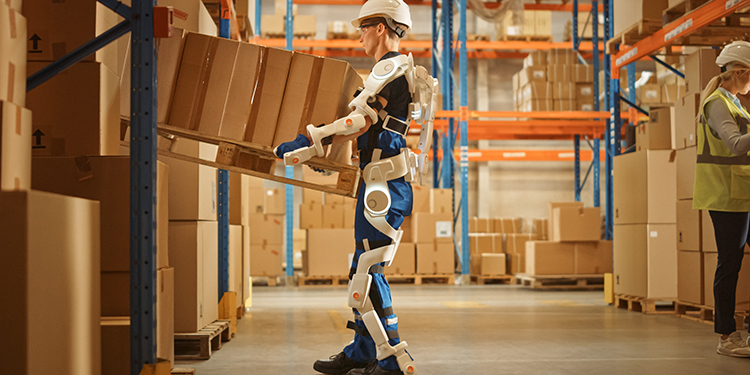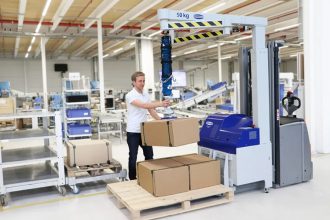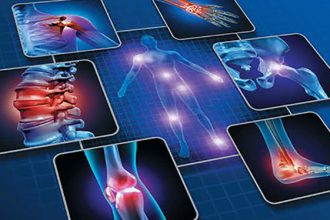Exoskeletons Have Potential To Help Workers Perform Manual Material Handling Activities Ergonomically, Efficiently

With the current U.S. workforce both aging and not as fit as it was 25 years ago, companies are examining a variety of ergonomic assist solutions to help workers perform manual, repetitive material handling activities safely and efficiently. One such technology currently in development and beginning to make inroads into factories and warehouses are exoskeletons (also referred to as “exos”), lightweight external frames are worn to support the human body and enhance its physical capabilities in order to boost performance and reduce the risk of injury. Additionally, they can be designed to minimize or prevent strains caused by movements associated with poor ergonomics — such as overexertion, reaching, stretching, pushing, pulling, carrying heavy loads, bending and twisting — by physically restricting the wearer from doing so.
The use of exoskeletons in materials handling is a topic studied by Dr. Donald R. Peterson, Dean of the College of Engineering and Engineering Technology at Northern Illinois University, who has more than 25 years of experience in biomedical engineering and medical research. Investigating occupational exoskeleton use is one of his focus subjects; he also serves as the Chair of the ASTM International Committee F48 on Exoskeletons and Exosuits, which works continuously on the development and maintenance of standards for this emerging technology. Dr. Peterson will be sharing the latest advances in exoskeleton design and material handling applications with the members of the Ergonomic Assist Systems & Equipment (EASE) Industry Group on May 21, 2021, at MHI’s Spring Meeting.
Currently, there are roughly 120 companies developing exoskeletons for a variety of different applications, he says.
“Of those, there’s maybe four or five that are actually being used in material handling applications, and of those it’s mostly in manufacturing right now,” Dr. Peterson notes. “As a community — including the developers, researchers, users, sellers, designers and more — everyone is focused on enhancing the safety of the wearer.
“The goal is to create an exoskeleton that is user friendly, helps reduce fatigue, and assists the wearer to manage what would be considered possibly an unmanageable load. That is, one that’s perhaps light, highly repetitive or unwieldly — not something that’s super heavy,” he explains. For that reason, he anticipates that pick-and-place tasks will be the first area in which the exoskeletons will be most extensively applied to material handling processes.
As this nascent technology begins to enter the commercial marketplace, Dr. Peterson says that a few key points should be observed to ensure the success of the application. “First, it’s important to match the exoskeleton to the task at hand. Different exos provide different assistance advantages; there’s no one-size-fits-all. Rather, it’s important that the designer of the exoskeleton understand the process in which the unit is going to be used, and that the wearer understands its limitations.”
Second, he continues, training of the wearer is crucial. “Although exoskeleton designs are targeted to be intuitive and easy to use, we don’t want an exoskeleton to give an individual a false sense of being superhuman,” he explains. “That could cause an injury that the exo is intended to prevent. So proper training is very important.”
Third, the exoskeletons themselves require regular, if not daily, adjustment and maintenance. “Again, we’re at the outset of exoskeletons as a technology, so refinements must be made to ensure the unit is performing correctly,” he continues. “Also, these solutions are so new, there’s not a lot of data available yet on the reliability and durability of the exos and their components. But, without a doubt, like all mechanical systems, exoskeletons will require a continuous maintenance program.”
Finally, the exoskeletons themselves — while somewhat adjustable — need to be sized to the scale of each person wearing them. One designed for a smaller framed person would not be appropriate for someone with a larger body type, Dr. Peterson adds.
Further, “when you think about the past year as well, with COVID, there will need to be consideration given to whether or not a company wants multiple employees to share one exoskeleton,” he continues. “And, if they do, how will it be sanitized?”
During his presentation to the EASE Industry Group at the MHI Spring Meeting, Dr. Peterson will discuss the current state of exoskeleton technology and its applications in material handling, as well as an update on where the standards are in development. He will also be sharing his latest research findings and answering questions. Guests interested in attending the EASE membership meeting to hear Dr. Peterson speak should contact Anna Harreveld at aharreveld@mhi.org.
Looking for more ideas for improving the safety and efficiency of your workforce? The members of the Ergonomic Assist Systems & Equipment (EASE) Industry Group of MHI are available to consult, answer questions and make recommendations.



